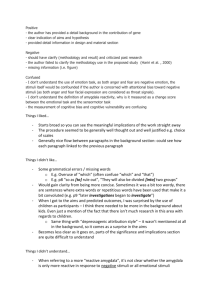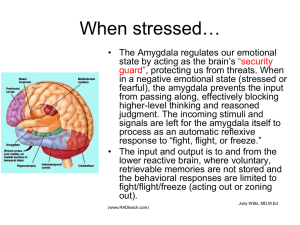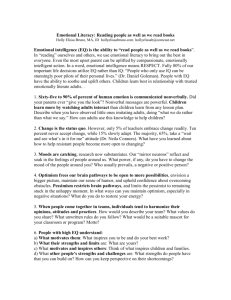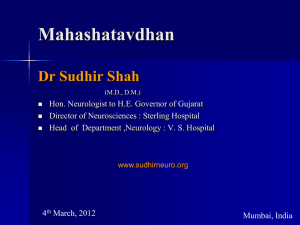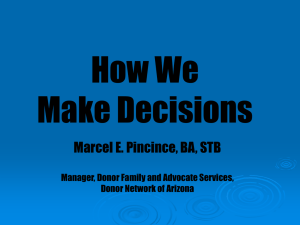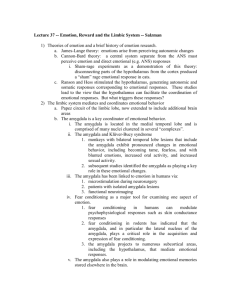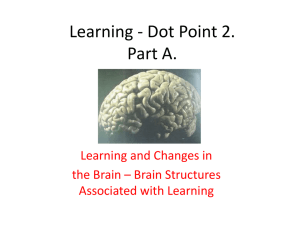Emotions and the Brain: Fear
advertisement
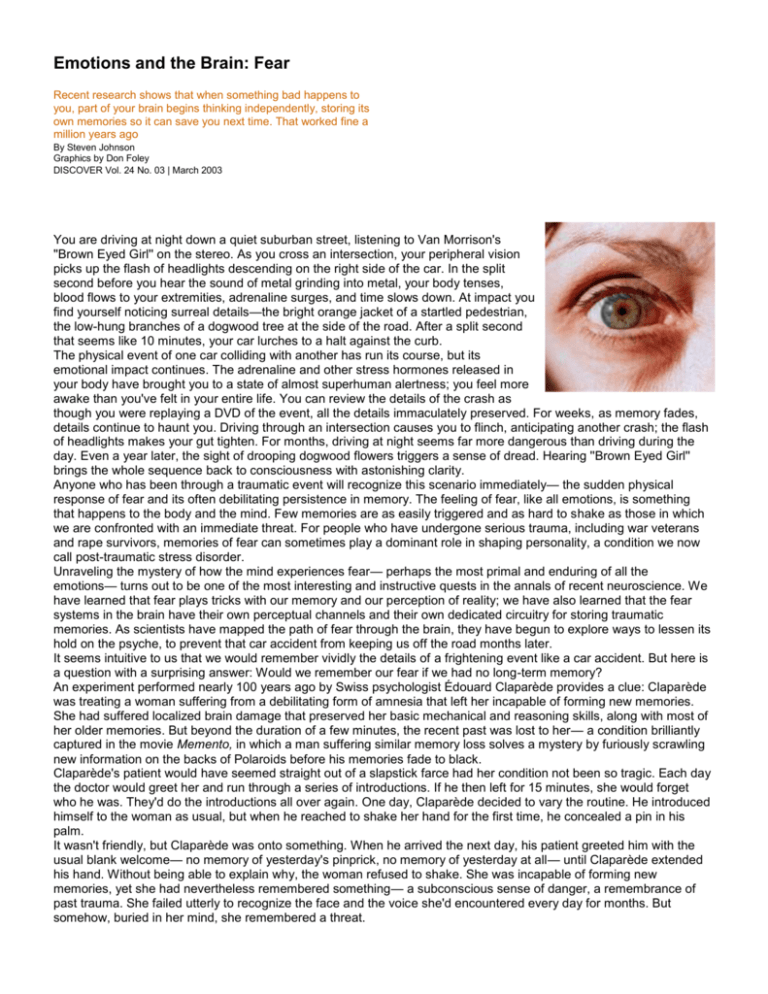
Emotions and the Brain: Fear Recent research shows that when something bad happens to you, part of your brain begins thinking independently, storing its own memories so it can save you next time. That worked fine a million years ago By Steven Johnson Graphics by Don Foley DISCOVER Vol. 24 No. 03 | March 2003 You are driving at night down a quiet suburban street, listening to Van Morrison's ''Brown Eyed Girl'' on the stereo. As you cross an intersection, your peripheral vision picks up the flash of headlights descending on the right side of the car. In the split second before you hear the sound of metal grinding into metal, your body tenses, blood flows to your extremities, adrenaline surges, and time slows down. At impact you find yourself noticing surreal details—the bright orange jacket of a startled pedestrian, the low-hung branches of a dogwood tree at the side of the road. After a split second that seems like 10 minutes, your car lurches to a halt against the curb. The physical event of one car colliding with another has run its course, but its emotional impact continues. The adrenaline and other stress hormones released in your body have brought you to a state of almost superhuman alertness; you feel more awake than you've felt in your entire life. You can review the details of the crash as though you were replaying a DVD of the event, all the details immaculately preserved. For weeks, as memory fades, details continue to haunt you. Driving through an intersection causes you to flinch, anticipating another crash; the flash of headlights makes your gut tighten. For months, driving at night seems far more dangerous than driving during the day. Even a year later, the sight of drooping dogwood flowers triggers a sense of dread. Hearing ''Brown Eyed Girl'' brings the whole sequence back to consciousness with astonishing clarity. Anyone who has been through a traumatic event will recognize this scenario immediately— the sudden physical response of fear and its often debilitating persistence in memory. The feeling of fear, like all emotions, is something that happens to the body and the mind. Few memories are as easily triggered and as hard to shake as those in which we are confronted with an immediate threat. For people who have undergone serious trauma, including war veterans and rape survivors, memories of fear can sometimes play a dominant role in shaping personality, a condition we now call post-traumatic stress disorder. Unraveling the mystery of how the mind experiences fear— perhaps the most primal and enduring of all the emotions— turns out to be one of the most interesting and instructive quests in the annals of recent neuroscience. We have learned that fear plays tricks with our memory and our perception of reality; we have also learned that the fear systems in the brain have their own perceptual channels and their own dedicated circuitry for storing traumatic memories. As scientists have mapped the path of fear through the brain, they have begun to explore ways to lessen its hold on the psyche, to prevent that car accident from keeping us off the road months later. It seems intuitive to us that we would remember vividly the details of a frightening event like a car accident. But here is a question with a surprising answer: Would we remember our fear if we had no long-term memory? An experiment performed nearly 100 years ago by Swiss psychologist Édouard Claparède provides a clue: Claparède was treating a woman suffering from a debilitating form of amnesia that left her incapable of forming new memories. She had suffered localized brain damage that preserved her basic mechanical and reasoning skills, along with most of her older memories. But beyond the duration of a few minutes, the recent past was lost to her— a condition brilliantly captured in the movie Memento, in which a man suffering similar memory loss solves a mystery by furiously scrawling new information on the backs of Polaroids before his memories fade to black. Claparède's patient would have seemed straight out of a slapstick farce had her condition not been so tragic. Each day the doctor would greet her and run through a series of introductions. If he then left for 15 minutes, she would forget who he was. They'd do the introductions all over again. One day, Claparède decided to vary the routine. He introduced himself to the woman as usual, but when he reached to shake her hand for the first time, he concealed a pin in his palm. It wasn't friendly, but Claparède was onto something. When he arrived the next day, his patient greeted him with the usual blank welcome— no memory of yesterday's pinprick, no memory of yesterday at all— until Claparède extended his hand. Without being able to explain why, the woman refused to shake. She was incapable of forming new memories, yet she had nevertheless remembered something— a subconscious sense of danger, a remembrance of past trauma. She failed utterly to recognize the face and the voice she'd encountered every day for months. But somehow, buried in her mind, she remembered a threat. About 25 years ago, a young postdoctoral student at weill Medical College of Cornell University in Manhattan named Joseph LeDoux was casting about for a research focus. Cognitive science, with an emphasis on computer modeling, was the hot new field. But LeDoux was interested in emotions, and "there wasn't a lot going on there,'' he remembers, sitting in his office at New York University, where he is a professor of neural science. ''So I read around and came across studies on fear conditioning." Claparède's pin turns out to be a somewhat diabolical twist on the classic behaviorist experiment of fear conditioning: Put a rat in a cage, play a tone, and simultaneously deliver a shock to the animal. After a few rounds of tone and shock, the rat starts to fear the tone even if it's not accompanied by the shock. The fear reaction— noticeable because the rat freezes in place— has been observed in species as diverse as pigeons, rabbits, baboons, and humans. It is called a conditioned response. The rat has an unconditioned innate fear of shocks, but it can be conditioned to be afraid of tones if the two are associated with each other. In Claparède's version of the experiment, the pin was the shock. His outstretched hand was the tone. After only one exposure to the shock and the tone, the amnesiac patient acquired a conditioned fear response to shaking hands with her doctor. Conditioned fear is easy: Fruit flies, marine snails, even lizards can be trained to display defensive behavior in response to threatening stimuli, along the lines of the tone and shock experiments. Conditioned fear turns out to be one of the most essential techniques that natural selection stumbled across to increase the survival odds of organisms in an unpredictable environment. But until a few decades ago, we had almost no idea how that learning actually took place. The ubiquity of conditioned fear in the animal kingdom, combined with the amnesiac's ability to remember potential threats, made it clear that learning to be afraid involved different mechanisms than, say, learning how to ride a bicycle or memorizing the capitals of all 50 states. But what was the mechanism? That's what LeDoux set out to determine. There had been almost no research into how the fear response actually came into being. ''In fact,'' LeDoux says with a smile, ''my first grant on this topic in the early 1980s was turned down," because scientists reviewing his application believed it was impossible to scientifically study emotions. LeDoux forged ahead anyway. ''I started from the outside,'' he says. ''I had the sound that produced the fear response. I wanted to know: How does that sound go through the brain and create the response?'' Like most brain researchers in the age before advanced imaging technology, LeDoux's approach was surgical subtraction. Take a healthy rat and begin extracting specific parts of his brain. If you remove a region and the rat can still learn to associate the tone with the shock, then the region you've removed isn't relevant to fear conditioning. But if the rat stops learning, you know you've got something relevant. Click on the image to enlarge. (23k) The amygdala, which directs signal traffic in the brain when danger lurks, receives quick and dirty information directly from the thalamus in a route that neuroscientist Joseph LeDoux dubs the low road. This shortcut allows the brain to start responding to a threat within a few thousandths of a second. The amygdala also receives information via a high road from the visual cortex. Although the high road encodes much more detailed and specific information, the extra step takes at least twice as long— and could mean the difference between life and death. LeDoux says the disconnection between the two routes may underlie some disorders: "While in terms of survival it may be better to mistake a stick for a snake, people who have pathological fears may be treating sticks as snakes much of the time." — Jocelyn Selim Click on the image to enlarge. (85k) ANATOMY OF FEAR Within seconds of perceiving a threat, the ''Because the auditory pathways are fairly well worked out in mammals, I could use primitive amygdala sounds that as a starting point. I started with the top of the auditory pathway, which is the a general alarm. The auditory cortex. I took that out, and the animals learned fine. Then I went down one adrenal system promptly station to the auditory thalamus, took that out, and they couldn't learn at all. So that floods the body with meant that the sound had to go through the system to the level of the thalamus but adrenaline and stress didn't go through the cortex. So where was it going?'' The question was puzzling hormones. Nonessential because the traditional understanding of the brain's activity emphasized the role of the physiological processes cortex over most other regions. The cortex was where the sensory information— in this switch off. Digestion stops, case, the sound of the tone— was integrated into conscious awareness, alongside skin chills, and blood is other sensory data transmitted from other parts of the brain. The auditory thalamus diverted into muscles in was supposed to be just a relay station from the ear to the primary destination, the preparation for a burst of auditory cortex. So there was something strangely inverted about LeDoux's result. You emergency action. could eliminate the primary destination altogether without affecting the learning, but if Breathing quickens, the you took out the relay station, the learning stopped. heart races, and blood LeDoux's assumption was that the auditory thalamus harbored a link to another part of pressure skyrockets, the brain, in addition to its link to the cortex. Using a tracer dye to follow pathways out infusing the body with from the auditory thalamus, LeDoux discovered a connection to the amygdala, an oxygen while the liver almond-shaped region in the forebrain long associated with emotional states. When he releases glucose for quick removed the amygdala, the rats failed to learn. Perusing the literature, he found earlier fuel. The entire body is experiments that demonstrated a crucial part of the amygdala known as the central suddenly in a state of high nucleus contained links to the key brain stem areas that control the autonomic alert, ready for fight or functions involved in the fear response, like acceleration of breathing and heart rate. ''I flight. didn't start out looking for the amygdala,'' LeDoux says. ''The research led me to it.'' — J. S. The key insight that emerged is that the experience of danger follows two pathways in the brain: one conscious and rational, the other unconscious and innate. These were quickly dubbed the high road and the low road. Say you're walking though a forest, and out of the corner of your eye you detect a slithering shape to your left, accompanied by a rattling sound. Before you even have time to formulate the word snake, your body has frozen in its tracks; your heart rate has accelerated; the sweat glands on your palms have dilated. In your brain, the information flow looks something like this: Your eyes and ears transmit basic sensory information to the auditory and visual thalamus, where the information is then transmitted along two paths. One stream of data heads towards the cortex, where it will be integrated with other real-time sensory data, along with more elaborate associations like the word rattlesnake, or your childhood memories of a pet python, or the snake scene from Raiders of the Lost Ark. At the same time, the slithering is also transmitted— in less rich detail— to the amygdala itself, which blasts out an alarm to the brain stem, alerting the body that a potential threat is nearby. The key difference between the two paths is data transmission time. It might take a few seconds to establish the presence of the snake and formulate a response via the high road, but the low road kicks the body into a freezing response within a fraction of a second. And you don't have to learn the elaborate bodily choreography involved, the way you might learn a complicated yoga position. Your body knows how to execute the freezing response without any training at all. In fact, it knows the response so well that it is nearly impossible to keep it from happening. As a survival mechanism, LeDoux's low road made perfect sense. But other questions remained: How did the amygdala know to be afraid of a snake in the first place? How could Claparède's patient learn to be afraid if she lacked memory? We're accustomed to describing someone as having a good or a bad memory, as though memory were a single attribute that covers the entire range of storing and recalling information. We now know that the brain's memory systems are far more diverse than this. There are systems devoted to explicit or declarative memories, like your childhood recollection of that pet python, and systems devoted to procedural memories that usually involve physical movement, like learning how to ride a bicycle. And then there are emotional memories. If you watch the activity in someone's brain using a modern fMRI scanner, you see a different profile depending on which kind of memory the subject is conjuring up. In ordinary cases of fear conditioning— encountering that snake in the grass— a declarative memory will occur more or less simultaneously with an emotional memory. You'll feel the freezing response kick in, and moments later you'll remember seeing that scene from Raiders of the Lost Ark. The latter feels like our traditional idea of memory; there's a mental picture from the past experience that comes into consciousness, as though you were sifting through pages of a photo album. The transition to a freezing response doesn't feel like a memory in that conventional sense of the term, but for all intents and purposes it is one. It is recalled information from past experience that alters your state of mind. The transition to a freezing response happens too fast for it to be a conscious, deliberate memory, but it's a form of memory nonetheless. In brain anatomy terms, the declarative memory of Indiana Jones in the snake pit is laid down by the hippocampus, a long, curved ridge located next to the amygdala. The emotional memory of a threat, on the other hand, is mediated by the amygdala itself. This explains the mystery of the remembered pinprick: Claparède's patient lacked the ability to form declarative memories, but she had a functioning amygdala that kept the memory alive, albeit unconsciously. If you had a past encounter with a snake and you felt actively threatened, a trace of that memory would have been stored by the amygdala as well as by the hippocampus. Some brain scientists believe that our fear systems are prepared to learn about threats— snakes, spiders, or heights— that have been major obstacles to survival over the millions of years it has taken the modern brain to evolve, which explains why it is easier to develop phobias about snakes than about threats that are statistically much more likely to kill you, such as electricity. Some scientists believe the amygdala doesn't have its own discrete storage system for emotionally charged memories but rather marks memories created by other brain systems as being somehow emotionally significant. In 2001 James McGaugh of the University of California at Irvine conducted a telling variation on the classic fear-conditioning experiment. He took a rat and subjected it to the traditional foot shock if the animal took a step. After administering the shock, McGaugh injected cyclic AMP— a cellular messenger that strengthens neuronal synapses, leading to stronger memory— into the animal's cortex. Two days later, the rats were tested to see how well they were conditioned; those that received the injections turned out to have enhanced memories of the shock. ''So we know the cortex is involved in the memory that's based on fear in that situation,'' McGaugh says. ''Now, if we make a lesion of the amygdala, the stimulation of the cortex doesn't do anything. In other words, you have to have a working amygdala for the cortex to do its job.'' McGaugh concludes, ''That experiment tells me that fear is not learned in the amygdala. Amygdala projections are coming up to brain regions where information is being stored, and they're saying: 'You know this memory you're storing? Well, it turns out to be a very important one, so make it a little stronger, please.' It provides selectivity in our lives. You don't need to know where you parked the car three weeks ago, unless it was broken into that day.'' You can think of it as the brain's way of underlining. Neuroscientists have determined that the memory of a fear stimulus triggers dramatic changes in the vital signs of rats. In a series of conditioned-response experiments, rats are first exposed to a painful shock accompanied by a tone. Whenever the tone is repeated, the rats immediately stop dead in their tracks. Blood pressure shoots up within three seconds, and heart rate peaks within five seconds. After 20 seconds, increased levels of stress hormones like corticosterone flood the body, and highly oxygenated and fuel-charged blood is pumped into the muscles to prime them for action. The trouble with emotional memories is that they can be fiendishly difficult to eradicate. The brain seems to be wired to prevent the deliberate overriding of fear responses. Although there are extensive neural pathways from the amygdala to the neocortex, the paths running the reverse direction are sparse. Our brains seem to have been designed to allow the fear system to take control in threatening situations and prevent our conscious awareness from reigning. This may have been an optimal design for predator-rich environments in which survival was a minute-by-minute question, but it is not a good adaptation for modern environments in which the stressors can be job performance reviews. The amygdala may be looking out for your best interests by preserving a memory of that nighttime car accident, but if the result is an inability to drive after dark, the fear circuitry has gone too far. Because the low-road memories are so tenacious, one question neuroscience is now wrestling with is how to subdue the amygdala when those memories hurt the organism. As a New Yorker who works in downtown Manhattan, LeDoux has been thinking a lot about these issues since September 11, 2001. Many local residents experienced a conditioned fear response that day, making it hard for them to work in tall buildings or visit the downtown area. LeDoux suspects those traumatic memories will persist in the brains of New Yorkers. The treatment possibilities are not about eliminating the memories so much as retraining the amygdala to respond differently when those memories are triggered. ''The contrast,'' LeDoux says, sitting in his university office above Washington Square Park, with Ground Zero lurking not far to the south, ''is between taking action and being stuck, frozen in fear, headed toward despondency, unable to control your life. There's an interesting experiment along these lines: You have a rat that goes into a chamber. A tone goes off, and he gets a shock, and he freezes with the fear response. The next day he goes into chamber B, the tone goes off, and he freezes. But if he takes a step, the tone stops. Eventually he learns that he has to crawl across the chamber to eliminate the tone completely. So by taking that action, he's able to prevent fear from existing in his life. ''In order for the rat to do this,'' LeDoux continues, standing up to sketch out his ideas on a cluttered white board, ''he's got to throw a switch in the amygdala. Normally, the fear response goes from the lateral nucleus to the central nucleus and then out of the amygdala. In order for the rat to take a step, the stimulus has to go not to the central nucleus but to the basal nucleus, and then out to the parts of the brain that are involved in active behavior.'' In other words, the amygdala wants to associate the memory with the freezing response, but it can be trained to associate it with something less debilitating. When you hear an airplane rumbling overhead, you can freeze, or you can take a step. And with every step you reroute the path of fear through the amygdala. Our new understanding of fear has also led to cunning pharmacological treatments for post-traumatic stress disorder. McGaugh talks about two recent studies that involved giving beta-blockers to people who had recently suffered a traumatic event, studies that built on McGaugh's own research: ''Say you have a traumatic experience. The memory of that experience will pop into your brain the next day, whether you want it to or not. And when that memory pops into your brain, you're going to have that whole autonomic response that you had originally. It's going to come back again. So it's not only that you remember that you were mugged, but you also get very emotionally excited about it when the memory happens.'' That emotional excitement triggers the memory-enhancing cycle all over again, making the traumatic memory even stronger, like a spinning tire deepening the muck hole it's stuck in with each jab on the accelerator. By preventing the autonomic reaction, beta-blockers keep the memory from forming deeper grooves in the brain, making post-traumatic stress symptoms less severe, ''which I think is a really interesting development,'' McGaugh says with a hearty laugh. ''Forty-five years of my life I've spent studying rats and out pops something useful!" Because the fear response can play a direct role in life-and-death struggles, it's not surprising to find that the brain contains elaborate machinery dedicated to its routines. The fact that the amygdala's basic architecture reappears in so many species is testimony to its evolutionary importance: Natural selection generally doesn't tinker with components that have proved essential to basic survival. Of course, the persistence of the low road in a world where predators are largely nonexistent may no longer be adaptive, but that's the trade-off of human culture. Evolution made our brains so smart that we ended up building environments that made some of our mental resources obsolete. No matter how calculating and erudite the neocortex becomes, it can't simply switch off the amygdala. In that sense, you can see the battles between these different regions as a re-enactment of Freud's clash between man's civilized superego and his primal id. There is great elegance in the way this system has evolved, with its complex mix of instinct and learning. Like all emotions, the fear circuitry steers the organism toward desirable states— away from predators or other threats— without knowing that much in advance about the world that the organism will actually inhabit. We are not slaves to our emotions, but they are hardly at our beck and call either. They propel us in directions that our rational minds don't always understand— fear most of all. The amygdala, like the heart in Pascal's famous phrase, has reasons of which reason knows nothing. For more from Joseph LeDoux, see The Emotional Brain: The Mysterious Underpinnings of Emotional Life (New York: Touchstone Books, 1996), or visit the LeDoux laboratory home page at www.cns.nyu.edu/home/ledoux. For a look at current research on fear, see the Web page of the New York University Center for the Neuroscience of Fear and Anxiety at www.cns.nyu.edu/CNFA. For a historical view of the science behind emotions, check out the Salk Institute's Emotion home page at emotion.salk.edu/emotion.html. For an interview with LeDoux, see "Parallel Memories: Putting Emotions Back Into the Brain: A Talk With Joseph LeDoux" at www.edge.org/3rd_culture/ledoux/ledoux_p2.html. For an audio interview, check out National Public Radio's March 29, 2002, Science Friday segment, "Synaptic Self" at www.sciencefriday.com/pages/2002/Mar/hour2_032902.html. Learn more about fear, specifically the role of the amygdala in post-traumatic stress disorder: "Kernel of Fear" by Mark Caldwell, Discover, June 1995. This article is available at www.discover.com.

